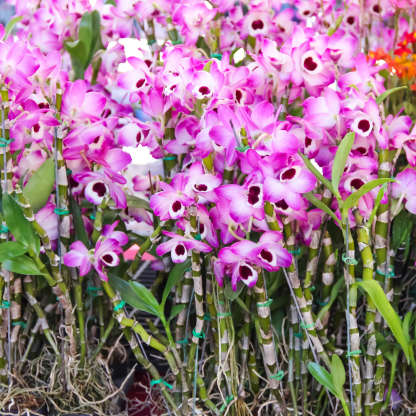How to care for dendrobium orchids
Introduction to Dendrobium Orchids
Welcome to the colorful world of dendrobium orchids! These exquisite flowers are not only a feast for the eyes but also a delight to care for. Whether you are a seasoned plant enthusiast or just starting your journey into orchid cultivation, this guide will equip you with all the knowledge needed to keep your dendrobiums thriving and blooming beautifully. Let's dive in and discover the secrets to successful care for these stunning plants!
Understanding the Different Types of Dendrobium Orchids
Dendrobium orchids are a diverse group of plants, with over 1,800 species and hybrids. These beautiful orchids can vary greatly in size, shape, and color, making them a popular choice among plant enthusiasts.
One common type is the Phalaenopsis-like Dendrobiums, which have large flowers resembling those of the Phalaenopsis orchid. Then there are the Nobile-type Dendrobiums known for their cane-like stems that bloom profusely along the length of each stem.
Another type is the Soft-Cane Dendrobiums with softer stems that sometimes need support as they grow taller. The Antelope-type Dendrobiums have unique blooms that resemble antelopes’ horns and can add an exotic touch to any collection.
Additionally, Australian Native Dendrobiums are sturdy plants native to Australia with vibrant colors and patterns on their flowers. Each type requires slightly different care routines to thrive and flourish in your home or garden.
Proper Lighting and Temperature for Dendrobium Orchids
When it comes to caring for your dendrobium orchids, providing the right amount of lighting and maintaining optimal temperatures are key factors in their overall health and blooming success. Dendrobium orchids thrive in bright, indirect light, so placing them near a window where they can receive plenty of natural light without being exposed to direct sunlight is ideal.
During the growing season, which typically spans from spring to fall, aim to keep your dendrobium orchids in temperatures ranging between 65-85°F (18-29°C) during the day and slightly cooler at night. This temperature fluctuation mimics their natural habitat conditions and encourages healthy growth.
If you notice that your dendrobium orchid leaves are turning yellow or developing brown spots, it could be a sign of too much direct sunlight or heat exposure. On the other hand, if the leaves appear dark green with no new growth, it might indicate insufficient light levels. Adjusting their placement or using sheer curtains can help regulate the lighting intensity they receive effectively.
Remember that finding the right balance of lighting and temperature may require some trial and error as each environment varies. By observing how your dendrobium orchids respond to different conditions, you'll be able to create an optimal setting for these beautiful plants to flourish.
Watering and Fertilizing Techniques
When it comes to watering and fertilizing your dendrobium orchids, finding the right balance is key. These plants prefer a slightly drier environment compared to other orchid varieties, so be cautious not to overwater them. Allow the top layer of the potting mix to dry out before watering again.
For watering, it's recommended to use room temperature water and ensure good drainage in the pots. This helps prevent waterlogging which can lead to root rot. Fertilize your dendrobium orchids with a balanced orchid fertilizer at quarter strength every 2-4 weeks during their active growing season.
During the winter months or when the plant is not actively growing, reduce fertilization frequency. Always follow the instructions on the fertilizer packaging for best results. Remember, less is often more when it comes to caring for these beautiful plants!
Repotting and Pruning Tips
Repotting and pruning are essential tasks to keep your dendrobium orchids healthy and thriving. When it comes to repotting, make sure to choose a pot that allows for proper drainage. Dendrobium orchids prefer a mix of bark, perlite, and sphagnum moss for good airflow.
It's recommended to repot your dendrobium orchid every 2-3 years or when you notice the roots outgrowing the pot. When repotting, gently remove the old medium from the roots without causing damage. Pruning dead or yellowing stems is crucial as it promotes new growth.
Before pruning, sterilize your tools to prevent any infections in the plant. Trim back any unhealthy or overgrown parts carefully so as not to shock the plant. Remember always to use clean tools while working on your dendrobium orchids to avoid spreading diseases.
Proper repotting and pruning techniques will ensure that your dendrobium orchids continue to flourish year after year!
Common Pests and Diseases of Dendrobium Orchids
Dendrobium orchids, like any other plant, are susceptible to pests and diseases that can affect their health and growth. One common pest that orchid growers may encounter is the spider mite. These tiny creatures thrive in dry conditions and suck the sap from the leaves of dendrobium orchids, causing yellow spots and webbing.
Another pesky pest to watch out for is the mealybug. These soft-bodied insects feed on plant sap and leave behind a sticky residue that can attract mold. Keeping a close eye on your dendrobium orchids' leaves and stems can help you catch these bugs early before they cause significant damage.
In terms of diseases, fungal infections such as leaf spot or root rot can be problematic for dendrobium orchids if not addressed promptly. Ensuring proper air circulation around your plants, avoiding overwatering, and using sterile tools when pruning can all help prevent fungal issues from taking hold.
Regularly inspecting your dendrobium orchids for any signs of pests or diseases is crucial in maintaining their overall health. Treatments may vary depending on the specific issue at hand, so it's essential to research effective solutions or consult with a knowledgeable gardener if needed.
How to Encourage Blooming in Dendrobium Orchids
Encouraging blooming in your dendrobium orchids can be a rewarding experience for any plant lover. One key factor to remember is providing the right conditions for your orchid to thrive and bloom beautifully.
Proper lighting is essential for dendrobium orchids to bloom successfully. Place them in a location where they receive indirect sunlight, as too much direct sun can burn their delicate leaves.
Maintaining the right temperature range is crucial. Dendrobium orchids typically prefer daytime temperatures of 65-85°F (18-29°C) and nighttime temperatures around 55-60°F (13-16°C).
Regular watering is important, but avoid overwatering as it can lead to root rot. Allow the top inch of the soil to dry out before watering again.
Fertilize your dendrobium orchids during their active growing season, usually from spring to early fall. Use a balanced fertilizer specifically formulated for orchids.
To stimulate blooming, consider adjusting the light exposure or temperature slightly. Sometimes these small changes can trigger your dendrobiums to produce gorgeous flowers!
Conclusion
As you can see, caring for dendrobium orchids involves understanding their specific needs and providing the right environment for them to thrive. By following the proper lighting and temperature guidelines, watering and fertilizing techniques, as well as repotting and pruning tips, you can ensure that your dendrobium orchids stay healthy and vibrant.
Keep an eye out for common pests and diseases that may affect your orchids, taking proactive steps to prevent any issues. And don't forget to encourage blooming by providing the necessary care throughout the year.
With a little bit of knowledge and effort, you can enjoy the beauty of dendrobium orchids in your home or garden for years to come. Happy growing!



